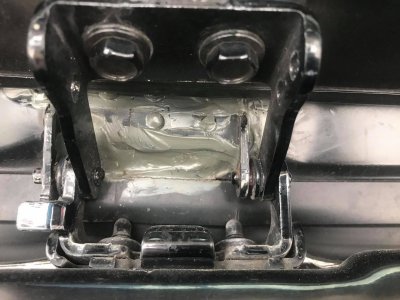After an extensive google search, I settled on 3M Windo-Weld (08690).
As I removed the old hinge, I noticed that the original adhesive did not actually adhere the metal hinge itself to the glass, even though there was adhesive between the hinge and glass. Yet, this hinge has lasted 17 years. I also noticed that the adhesive completely covered the hinge and was spread out over 12" (a good 6" both sides of the hinge), and was built up at least 1/8" over the hinge. This had lead me to surmise that the adhesive is not relying on adhering the hinge to the glass, but rather, using the adhesive to keep the hinge clamped to the glass. With this in mind, this is what I did:
1) Cleaned off all surfaces as much as I could, reasonably. I used a drum sander on my dremel which made quick work of removing old adhesive, even down to the glass. I did use a rotary brush on the hinge to remove as much old adhesive as I could. I removed enough old adhesive on the glass so that I could build it up again over the hinge, but left enough so that I could easily locate the hinge in its original position.
2) Washed the entire area with water. Because the area being repaired was well sanded, I felt it wasn't necessary to use any detergent or other solvent. In fact, the urethane sealant cures better with a little moisture.
3) Warmed up the tube of 3M 08690 inside a ziplock bag, in a sink of hot water.
4) Applied some painters tape to prevent over covering the area with adhesive.
5) Applied adhesive generously to the glass where the base would be located.
6) Pressed, by hand, the hinge to the glass, and wriggled it into position until I could feel it "lock" into the original position.
7) Applied more adhesive so that I would have a good 1/8" on top of the hinge, and spread it out about 3" past the sides of the hinge. I also smoothed it over as best I could with my gloved hand. The repair doesn't look pretty, but no one will be looking at it.
8) Set up a heater to increase the curing temperature to 90°F. A cure to 150 psi will be achieved between two to four hours, depending on relative humidity.
It is sitting curing right now, so I don't actually know if this is going to work or not. But, judging from what others have done, this repair with this adhesive has lasted several years.
It's my understanding that JBweld will crack out as soon as the heat expands the metal hinge. The only reasonable adhesive to use is this stuff from 3M, as far as I know.
As I removed the old hinge, I noticed that the original adhesive did not actually adhere the metal hinge itself to the glass, even though there was adhesive between the hinge and glass. Yet, this hinge has lasted 17 years. I also noticed that the adhesive completely covered the hinge and was spread out over 12" (a good 6" both sides of the hinge), and was built up at least 1/8" over the hinge. This had lead me to surmise that the adhesive is not relying on adhering the hinge to the glass, but rather, using the adhesive to keep the hinge clamped to the glass. With this in mind, this is what I did:
1) Cleaned off all surfaces as much as I could, reasonably. I used a drum sander on my dremel which made quick work of removing old adhesive, even down to the glass. I did use a rotary brush on the hinge to remove as much old adhesive as I could. I removed enough old adhesive on the glass so that I could build it up again over the hinge, but left enough so that I could easily locate the hinge in its original position.
2) Washed the entire area with water. Because the area being repaired was well sanded, I felt it wasn't necessary to use any detergent or other solvent. In fact, the urethane sealant cures better with a little moisture.
3) Warmed up the tube of 3M 08690 inside a ziplock bag, in a sink of hot water.
4) Applied some painters tape to prevent over covering the area with adhesive.
5) Applied adhesive generously to the glass where the base would be located.
6) Pressed, by hand, the hinge to the glass, and wriggled it into position until I could feel it "lock" into the original position.
7) Applied more adhesive so that I would have a good 1/8" on top of the hinge, and spread it out about 3" past the sides of the hinge. I also smoothed it over as best I could with my gloved hand. The repair doesn't look pretty, but no one will be looking at it.
8) Set up a heater to increase the curing temperature to 90°F. A cure to 150 psi will be achieved between two to four hours, depending on relative humidity.
It is sitting curing right now, so I don't actually know if this is going to work or not. But, judging from what others have done, this repair with this adhesive has lasted several years.
It's my understanding that JBweld will crack out as soon as the heat expands the metal hinge. The only reasonable adhesive to use is this stuff from 3M, as far as I know.

